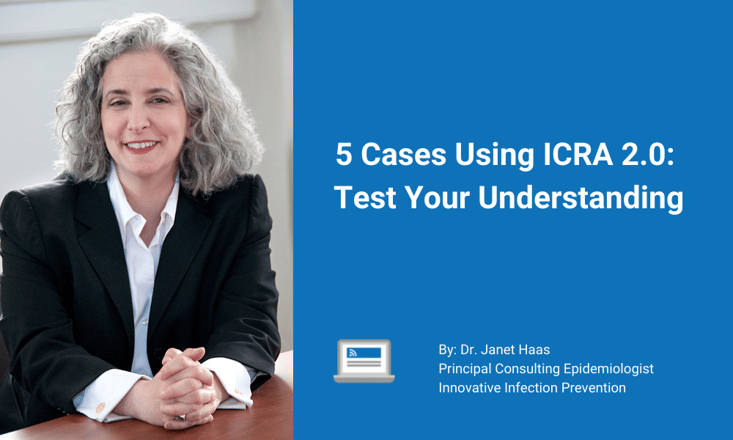
By JANET HAAS, PhD, RN, CIC, Principal Consulting Epidemiologist, Innovative Infection Prevention
The latest version of the infection control risk assessment has been called ICRA 2.0 to distinguish it from the original version that facility managers and infection preventionists have been using for several years. As mentioned in my previous blog post on this topic, ICRA 2.0 builds on many years of experience using the original ICRA and clarifies many areas that were not specifically addressed. In this post, we’ll apply ICRA 2.0 to some scenarios of construction and maintenance activities that are typical for healthcare facilities.
Using the tables below, try to decide where you think each scenario fits in the ICRA matrix, recognizing that there may be more than one answer depending on where the work will take place.
Scenario 1: Fire Suppression System Inspection and Maintenance
The safety officer is working with the facility maintenance team to inspect and perform annual maintenance on the fire suppression system in the facility. They will need to open ceiling tiles to inspect the system and, if needed, perform any minor repairs. They anticipate opening 2-3 tiles in each patient care unit. Areas requiring more extensive repair or maintenance will be flagged for future work, which will be done by an outside contractor.
Question: Which work type and construction class apply to this scenario?
Scenario 2: Upgrade to Medical Gas and HVAC Systems
The facility received an emergency preparedness grant to upgrade the medical gas and HVAC systems in preparation for a possible surge of infectious patients. A general medical unit will be retrofitted to upgrade the oxygen. Private rooms will have an additional headwall with oxygen, suction and electrical outlets so that the rooms can accommodate 2 patients if necessary. This is an 18-room unit, and the project will take 2 months to complete.
Question: Which work type and construction class apply to this scenario?
Scenario 3: Room Refreshes in a Post-Partum Unit
The facility maintenance department will be doing room refreshes in the post-partum unit, one room at a time as they become available. The nurse manager is working with the team to hold one room open each day. The project will involve paint and patch repairs, floor burnishing and other minor repairs to fixtures as needed, as well as the installation of a new infant security system which will require wiring from a central hub to each room.
Question: Which work type and construction class apply to this scenario?
Scenario 4: Addressing Mold in a Patient Room
While fixing a leaky toilet flush handle in a patient room, the plumber noticed some mold on the sheetrock behind the toilet. The supervisor notified building maintenance and bed management of the situation, and the room was closed for new patient admissions. The plan is to assess the extent of water damage and remediate the mold using an outside contractor.
Question: Which work type and construction class apply to this scenario?
Scenario 5: Electrical Installation in a Waiting Room (Outside ED)
A generous donor funded the installation of a phone charging station for the waiting room outside of the emergency department. There is a closet that will be repurposed to hold the charging unit. The work requires removal of a door and a steel closet rod from the closet, installation of an outlet from a nearby conduit and painting the closet interior. The work is estimated to take less than 1 shift to complete.
Question: Which work type and construction class apply to this scenario?
How did you do? Did you find the newer version of the ICRA easy to use? Can you think of some situations that will require your facility to plan differently? These scenarios were intended to show some common situations that are similar to those you are likely to see in your facility. The ICRA 2.0 gives much more detail and includes guidance for more areas and situations. Each facility will need to assess their own patient populations and resources and decide how best to implement these enhanced safety precautions during construction, maintenance and renovation.
Dr. Haas is Principal Consulting Epidemiologist at Innovative Infection Prevention and an associate editor of the American Journal of Infection Control (AJIC). She previously served as Director of Epidemiology at 3 academic medical centers, and as 2018 APIC President. Prior to beginning her nursing and infection prevention professional journey, Janet also worked as a Journeyman Millwright Mechanic and was a member of the Carpenter’s Union.

Interested in More Information on STARC Systems?

